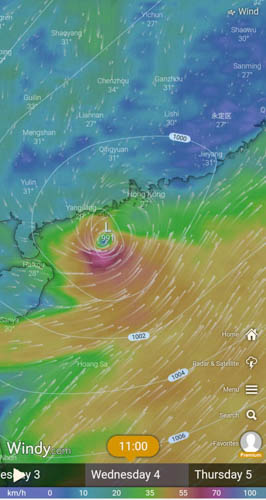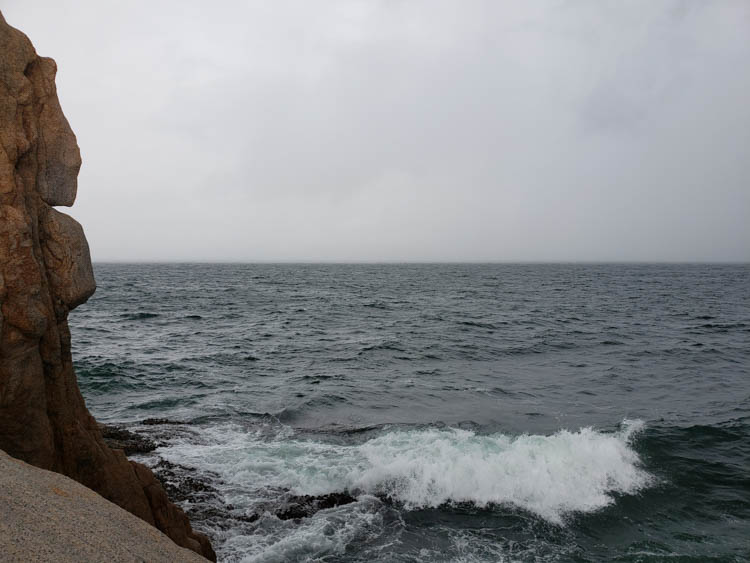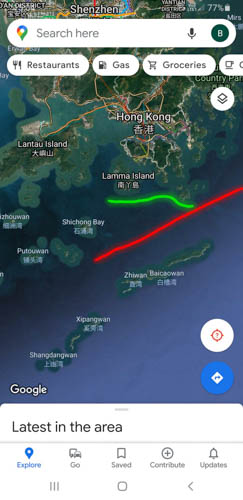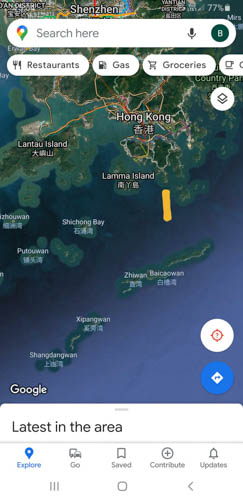3 to 5 August
August started with this relatively small weather system:


It was tropical storm Lupit that moved northeasterly and passed Hong Kong during this survey.
So
3 August was the first day of another short survey and thus the first for August. The weather was okay: rain and showers, but also long dry periods. Visibility was limited, as seen from this photo, normally you’d see the Dangan islands:




A shower on the horizon
Winds blew from the southeast, force 5. I watched from 11h45 until 17h45. At 16h25 the Hong Kong Observatory issued storm signal 3: it gave me good hope that the next day would see strong southerly to easterly winds, but the signal was withdrawn at 04h20 in the morning of 4 August. But let’s first look at the 3rd, which was not a bad day to start the month.
Seabirds:
1 immature Lesser Frigatebird, circling above Southern Hong Kong Waters, south of Lamma Island at 12h45
1 Red-footed Booby, to north at 14h15
Waders:
2 Red-necked Phalaropes, to northeast
2 Whimbrels, to northeast
1 Common Sandpiper present
Terns:
3 Greater Crested Terns, to west
2 Caspian Terns, to west
Other migrants:
3 Himalayan Swiftlets, to northeast.
Here’s the checklist:
https://ebird.org/checklist/S92698887.
On the way to the village, I saw that the small beach at Nam Kok Tsui was covered with debris:


On
4 August the wind was a lot less and coming from northerly directions. The storm had passed overnight, alas. The weather was mostly dry, a bit of rain but heavy showers at the end of the day. Northerly winds, force 2 (mostly) to 4/5.
There was good passage of terns throughout the day, indicating the autumn migration has started.
Seabirds:
3 Streaked Shearwaters, 1 group flying west at 07h52
Terns:
Bridled Terns; some in mixed groups with other species to west, so I’ll start counting them next time
29 Greater Crested Terns, flying west, amongst them at least 7 juveniles
26 Common Terns, flying west (1 flying to northeast)
2 Roseate Terns, flying west
1 Black-naped Tern
24 tern spec, flying west
Also:
3 Little Egrets, flying west
1 Grey Wagtail, flying over
6 Himalayan Swiftlets feeding for 2 hours near the rocks from 07h48, with 1 House and 1 Pacific Swift; c8 Himalayan Swiftlets at 11h50, so total count at least 8.
Here’s the checklist:
https://ebird.org/checklist/S92827803.
5 August was an even better day for terns, but not any seabird was seen. I was present from 06h15 until 13h00. The weather was cloudy, dry, with a few rainy periods. Winds were blowing from the northwest (indeed not ideal for seabirds), force 4 to 5.
Waders:
Quite a few left unidentified
1 Grey Plover
4 Whimbrel
Terns:
c100-150 Bridled Terns
61 Greater Crested Terns
55 Common Terns
2 Roseate Terns
Also one Himalayan Swiftlet when I was on the way to Nam Kok Tsui. Here the checklist:
https://ebird.org/checklist/S92828011.
Remarks
This short survey, three days with one afternoon, one morning and one full day, again produced very enjoyable birding with tubenoses, a rarity (the booby) and good passage of terns. I can once again only conclude that the Lema Channel and Southern Hong Kong Waters are a terrific birding area; every single survey since the end of April this year produced good birds/numbers. There certainly have been (a few very) quiet (half) days but the survey of always (at least) three days turned out to be great.
Interesting was the somewhat sudden start of the autumn migration of terns. During the previous survey (18-22 July) migrant species like Common Tern and Greater Crested Tern were still moving mostly to the northeast, but now almost all of them were flying west.
Additionally, some remarks on the direction of migrants. In spring and in June/July the ones that are heading to northern breeding or wintering (e.g. Short-tailed Shearwaters) grounds fly east-northeast to northeast and they are coming from west-northwest to west. The autumn migrants actually fly west, not really southwest. In both cases, birds seem to bent their route around Nam Kok Tsui. I have actually not been able to see migrants and seabirds flying along a southwest-northeast-axis, illustrated with the red line on the illustration below. It’s more a west-east-axis, the green line, which also does not seem to be straight.


It’s puzzling to me that birds coming from the north-northeast to east-northeast don’t fly straight to the southwest, but turn around Po Toi to head westwards. But of course, birds that are flying very near the Lema islands can not be seen from Po Toi, as the distance is at least 11 km.
In spring, it seems that all migrants and seabirds likely fly to the north almost up the Pearl River, then probably make a turn to the east, flying between the cluster of Chinese islands southwest to Lantau Island, and then approaching Po Toi from between Shijao and Lamma Island, while turning northeast but chose to round Po Toi and not fly between Beaufort Island and Hong Kong Island (and pass Cape D’Aquilar). So their route is not straight, but likely with quite some bends and curves.
Also interesting is that 3 of the 4 boobies I’ve seen flew along the same north-south-axis.


Booby lane
Two Brown Boobies (one flying south, the other flying north) and one Red-footed Booby flew in the same area, roughly 1 to 3 kilometers off Nam Kok Tsui, along that axis. It’s like we have a booby lane there ;-).
Note that there are three main watchpoints, consisting of different rock ‘platforms’ of different heights: one facing (roughly) southeast to northwest (the western watchpoint), one facing southwest to northeast (the eastern watchpoint) and one facing northwest to east (the southwestern watchpoint). Where to sit depends on the wind force (safety first!), direction and the height of the waves and where birds are mainly coming from. Species like most boobies and all Lesser Frigatebirds were seen from the western watchpoint and might not have been visible from the other watchpoint. So I certainly regularly miss birds.
In spring there has proven to be a peak of migration between 6 and 8 or 9 o’clock in the morning. It was similar in this few early autumn migration days during the above survey, but migrants did continue to pass after this peak period. Noticeably on 4 August, there also was a peak in tern movement in the late afternoon hours. So basically, I think the best strategy is to spend all day at Nam Kok Tsui, as migration just continues from early morning to late afternoon/early evening. Note that boobies also have appeared outside the peak periods, at 10h08, 10h39, 13h15 and 14h15.
[
Last edited by badesc at 7/08/2021 14:54 ]


